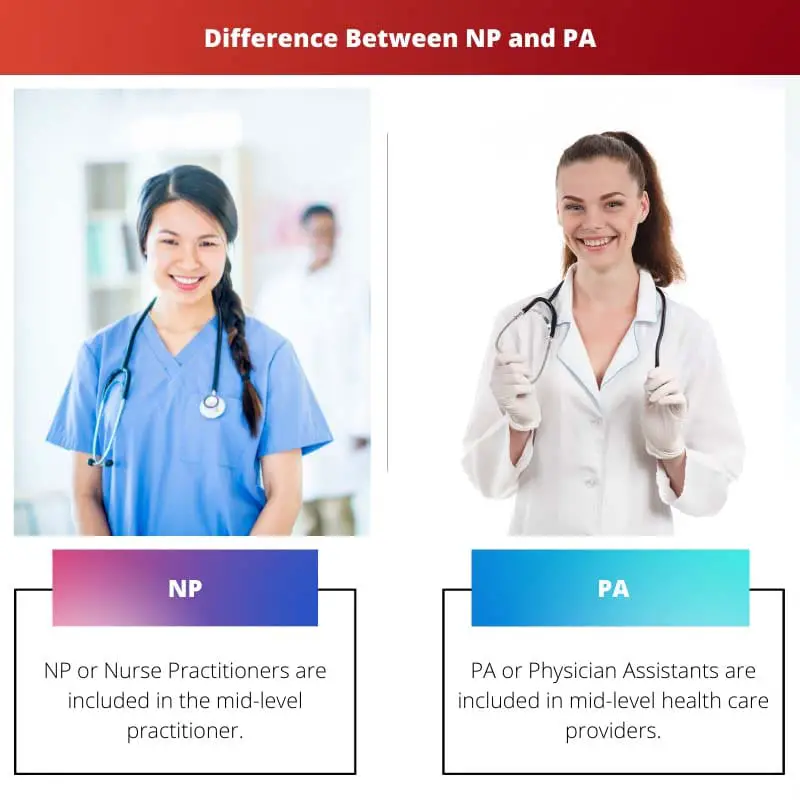The field of medical and medical professionals has manifested to be a white-collar job solely because of the majestic and noble work they do.
Every healthcare worker we visit is a highly qualified and trustworthy professional, but we may end up feeling confused between two professionals due to such a vast category.
For example, people always tend to assume that a nurse practitioner and a physician assistant are the same, but they are not. Learning the differences between them may prove to be helpful while visiting them.
Key Takeaways
- Nurse practitioners (NPs) possess advanced nursing degrees and clinical training, while physician assistants (PAs) complete medical training programs under physician supervision.
- NPs can practice independently in some states, but PAs always require physician collaboration.
- NPs emphasize a holistic, patient-centered approach, whereas PAs follow a disease-centered medical model.
NP vs PA
The difference between NP and PA is that NP stands for Nurse Practitioner, who are highly qualified and trained professionals, and they can even prescribe treatment plans and diagnose diseases without advice from a doctor, on the other hand, PA stands for Physician Assistant, who are equally qualified and are trained along with the Physicians so that in future they can assist them.

NP or Nurse Practitioners are included in the mid-level practitioner. They are registered nurses with an advanced level of training and practice.
Their responsibilities include aiding needy patients, providing insights and suggesting treatment plans, diagnosing diseases, and assisting a doctor once in a while. They cannot assist in diagnosing complex diseases.
On the other hand, PA or Physician Assistants are included in mid-level health care providers. Their responsibilities include prescribing medications and being constantly available to assist and agree with the physician.
Their degree is concluded early than any other medical degree, and they do not pursue residency training.
Comparison Table
| Parameters of Comparison | NP | PA |
|---|---|---|
| Stands for | Nurse Practitioner | Physician Assistant |
| Educational Qualification | Post- Baccalaureate Training (1.5 years) | Physician Assistant Training or Physician Associate Training |
| Clinical Exposure/ Training | Minimum 500 Hours of Clinical Training | Minimum 3000 Hours of Patient Contact |
| Duration of Degree | Approx. 2-4 Years | Approx. 27 Months |
| Responsibility/ Tasks | Basic Disease Prevention, Aiding Patients, Health Promotion, etc. | Conducting Physical Examinations, Prescribing medications, Patient Counseling, etc. |
What is NP?
As aforementioned, NP or Nurse Practitioners are trained medical professionals who provide specialized care to patients.
Although the process of pursuing a degree to become a Nurse Practitioner varies from country to country, primarily in every country, they need to pursue a post-graduate nursing degree.
They are referred to as Registered Nurses (RN) with extended and advanced clinical training.
In the United States, the concept and profession of a Nurse Practitioner were introduced in the mid-1960s due to the shortage of physicians. The United States extended the rules for Nurse Practitioners to serve as primary care providers.
Recently, they introduced a Doctor of Nursing Practice (DNP) to be the basic qualification required to become a Nurse Practitioner. Some protocols vary even in certain states of the United States.
Similarly, in Australia, the scope of practice of Nurse Practitioners has been extended by granting them better clinical exposures and training them with better clinical skills, which will be helpful in emergency cases and extended care units.
In Australia, they are allowed to process diagnostic tests like pathology, imaging, etc.
Almost in all countries worldwide, the registration and licensure of a Nurse Practitioner is mandatory and is conducted by the National or State Boards of a country.
For example, in Australia, this procedure is carried on by the Nursing and Midwifery Board of Australia (NMBA), while the Canadian Nursing Association (CNA) looks after this in Canada.
The tasks of a Nurse Practitioner include conducting diagnostic tests, providing counseling to certain patients, improving lifestyle habits, etc. The field of Nurse Practitioner carries many specializations like Family, Psychiatric, Pediatric, Neonatal, etc.
As much as this job is risky and hectic, it is a dignified and highly paid job with salaries extending up to 98,000-197,000 dollars.

What is PA?
As mentioned above, PA or Physician Assistant is an officially graduated medical profession. They pursue their degree along with other physicians, but they receive validation and certificate through the Physician Assistant Program.
They are granted licenses by the State or National Medical Council.
A Physician and a Physician Assistant majorly focus on the cure of the ailment or disease, like evaluating the disease and providing proper diagnosis, tests, and treatment.
Physician Assistants can perform research on various complex diseases and also can perform minor surgeries.
The duration of a Physician Assistant degree is less as compared to other medical degrees, but they are guaranteed maximum clinical exposure and training.
Initially, the course duration was less due to the shortage of qualified physicians during World War II.
Various abbreviations are used to denote a Physician Assistant in different countries, like PA-C in the United States, CCPA in Canada, PA in the Republic of Ireland, etc. PAs can specialize in the field of orthopedics and, dermatology, cardiology.
Physician Assistants train and collaborate with the Physicians even in complex surgeries. They can even perform surgeries if legally authorized by a Physician.
They can carry on their work in clinics, hospitals, or online modes like telemedicine, etc.
Although the mode of education, training, employment, and the scope of practice varies from country to country, the tasks and responsibilities remain almost the same for every country.

Main Differences Between NP and PA
- NP or Nurse Practitioners need not work under particular supervision, on the other hand, PA or Physician Assistants majorly work under a Physician.
- Nurse Practitioners focus on the overall well-being of a patient right from lifestyle to counseling, in contrast, Physician Assistants focus on disease diagnosis and treatment.
- Nurse Practitioners have many fields to specialize in, whereas Physician Assistants can specialize majorly in general medicine.
- Nurse Practitioners pursue a nursing degree, while Physician Assistants pursue a master’s medical degree program.
- Nurse Practitioners can prescribe medicines and treat the patients, while Physician Assistants can even perform surgery under the guidance of a Physician.
- Nurse Practitioners can provide basic treatment on the other hand, Physician Assistants can even diagnose and treat complex ailments.
- Nurse Practitioners require a new license when switching specializations, on the other hand, Physician Assistants do not need to apply for a new license while switching.

References
- https://europepmc.org/article/med/21478689
- https://www.researchgate.net/profile/RoderickHooker/publication/233814828_The_Globalization_of_the_Physician_Assistant_Profession/links/59e762630f7e9bed362bea7e/The-Globalization-of-the-Physician-Assistant-Profession.pdf